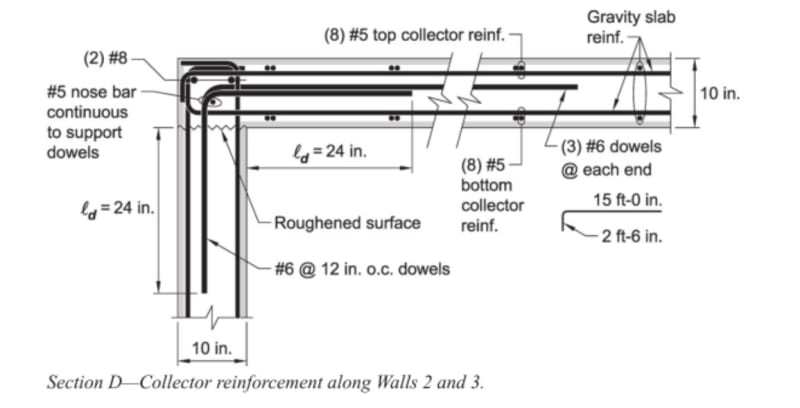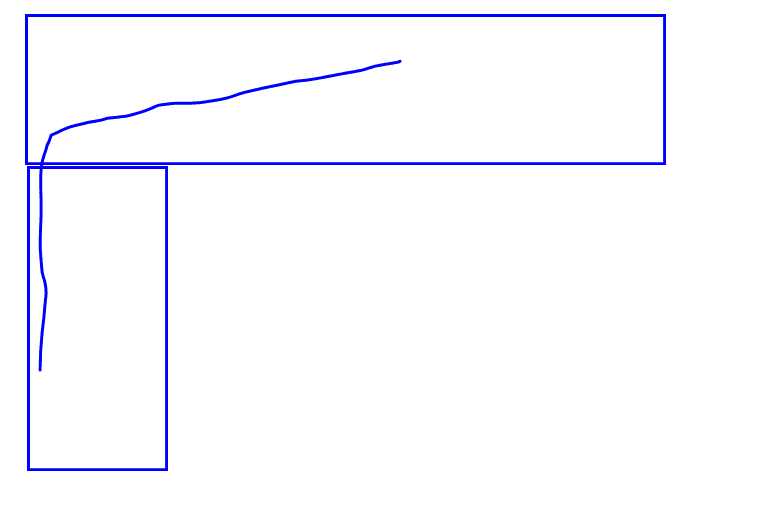Okay, I have been puzzling over this all day, and after pouring through ACI 318, Hilti, and other Eng-Tips threads, I finally decided to just ask. I am replacing an existing concrete roof slab in a simple building with 6" concrete walls and roof. The attached detail shows the planned replacement - chip away the existing slab around the existing embedded hooked dowel that connects the roof to the wall, and pour the new roof slab, using the existing dowel for diaphragm shear transfer to the shear wall.
The issue is that, with the roof being only 6" thick, I do not have enough length to develop the bar as a standard hook past the cold joint. Therefore, I can't use shear friction for the shear strength across that joint. I have enough shear strength in the rebar as only shear dowels, but I don't have the Chapter 17 edge breakout strength. From what I gather by reading past threads (see links below), I can't use a prorated shear friction strength based on reduced hook development length. Per ACI 22.9.4.5, I can use permanent net compression to reduce the required shear friction reinforcement, and there is net compression here from the dead load of the slab. If I combine the net compression times a conservative friction factor, plus the steel shear strength of the dowels, that's enough capacity. But, I'm leaning towards thinking that is combining two sections of code, neither of which I'm fully complying to, in order to get a combined total strength.
My detail is identical to the existing detail before replacing the slab, since the original design had a construction joint at the top of the wall where this new joint is. Was that just a bad detail, or am I missing some other code-supported method to demonstrate shear capacity across this joint? Do I have to detail this differently to get sufficient strength? I'd rather not have to drill in a bunch of new post installed dowels in such a thin wall. And even so, they would need to extend into some kind of parapet to get the development length.
Relevant other threads:
The issue is that, with the roof being only 6" thick, I do not have enough length to develop the bar as a standard hook past the cold joint. Therefore, I can't use shear friction for the shear strength across that joint. I have enough shear strength in the rebar as only shear dowels, but I don't have the Chapter 17 edge breakout strength. From what I gather by reading past threads (see links below), I can't use a prorated shear friction strength based on reduced hook development length. Per ACI 22.9.4.5, I can use permanent net compression to reduce the required shear friction reinforcement, and there is net compression here from the dead load of the slab. If I combine the net compression times a conservative friction factor, plus the steel shear strength of the dowels, that's enough capacity. But, I'm leaning towards thinking that is combining two sections of code, neither of which I'm fully complying to, in order to get a combined total strength.
My detail is identical to the existing detail before replacing the slab, since the original design had a construction joint at the top of the wall where this new joint is. Was that just a bad detail, or am I missing some other code-supported method to demonstrate shear capacity across this joint? Do I have to detail this differently to get sufficient strength? I'd rather not have to drill in a bunch of new post installed dowels in such a thin wall. And even so, they would need to extend into some kind of parapet to get the development length.
Relevant other threads:



